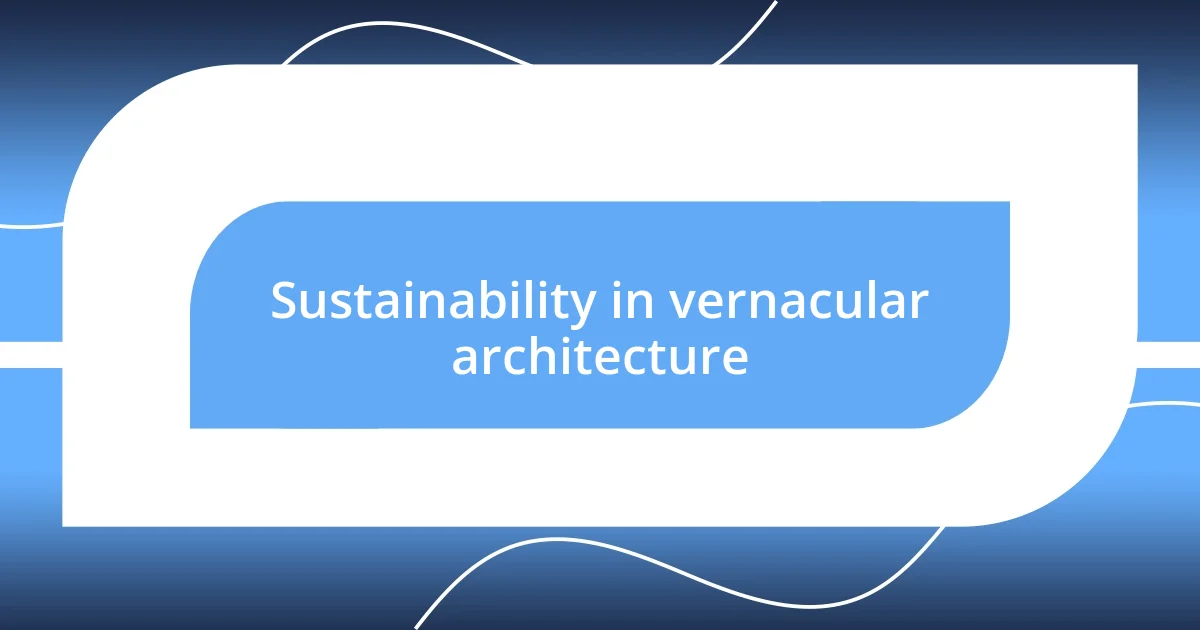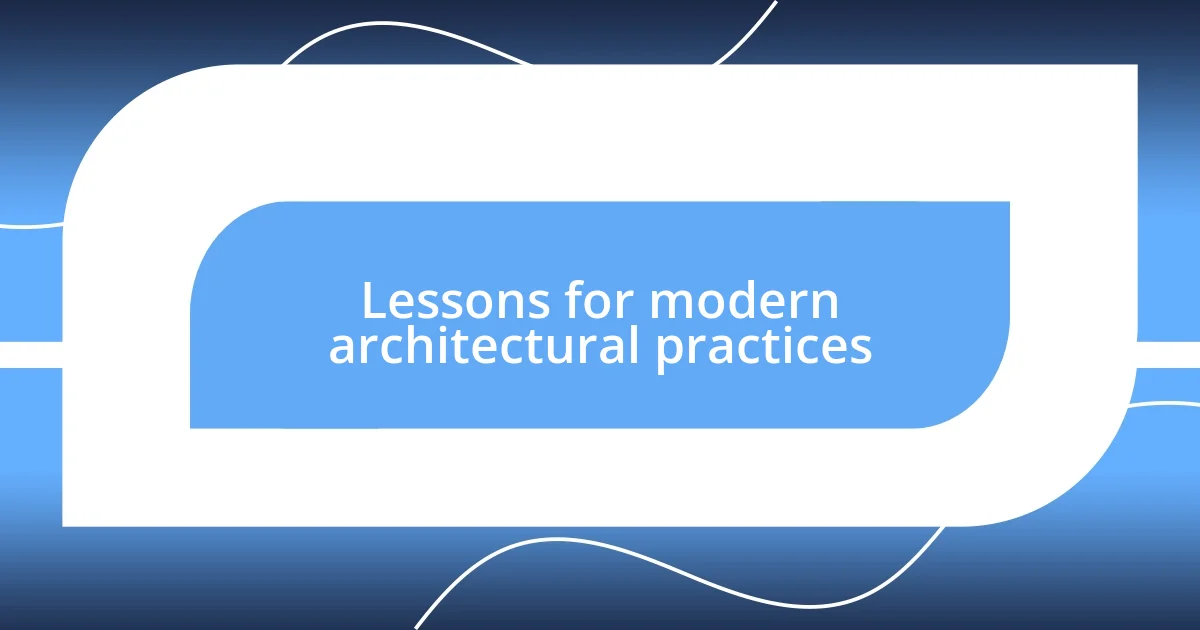Key takeaways:
- Vernacular architecture reflects the local environment, traditions, and resources, serving as a testament to community identity and resilience.
- Key characteristics include the use of local materials, environmental adaptation, and cultural significance, emphasizing sustainability long before it became a modern principle.
- Lessons from vernacular architecture can inform modern practices by prioritizing community integration, eco-friendly materials, and communal spaces in design.

Understanding vernacular architecture
When I first encountered vernacular architecture, I was struck by its deep connection to the local environment and culture. It’s fascinating how these structures tell a story of the people who built them, reflecting their traditions, available resources, and climatic conditions. Have you ever looked at a building and felt like it whispered the stories of its community? That’s the magic of vernacular architecture.
One memorable experience for me was visiting a small village where the houses were made entirely of clay and straw. The warm, earthy tones and organic shapes were so inviting. The people in that village explained how their architecture protects them from extreme weather while remaining sustainable. It made me realize how intelligent design often mirrors nature, reinforcing our bond with the world around us.
I also learned that vernacular architecture changes and evolves over time, influenced by modern needs and technologies. It raises an interesting question: How do we honor tradition while embracing innovation? My travels have taught me that the beauty of these structures lies not only in their aesthetics but in their practicality and resilience, adapting to the ever-changing needs of their inhabitants.

Historical significance of vernacular structures
The historical significance of vernacular structures is often rooted in their ability to encapsulate local customs and the historical context in which they were built. I remember walking through old neighborhoods, where the architecture felt like a treasure box of history. Each building echoed the voices of past generations, showcasing unique construction techniques and materials adapted to the local climate. It’s intriguing to consider how these structures have withstood the test of time, preserving cultural identity.
In my travels, I stumbled upon a fishing village where the homes were raised on stilts to combat flooding. This ingenuity was not simply a practical answer to environmental challenges; it was woven into the community’s history. The villagers shared stories passed down through generations, illustrating how their ancestors faced climatic dangers with creativity. It made me reflect on how vernacular architecture serves as a living testament to human resilience and adaptability.
Additionally, exploring these structures highlights the underlying principles of sustainability that have been practiced for centuries. I recall visiting a region where traditional adobe houses were constructed using techniques established long before modern sustainability became a buzzword. Listening to the locals describe their building methods, I felt a deep appreciation for their knowledge of ecology, which has contributed to communities thriving while being in harmony with nature. Vernacular architecture, in essence, teaches us that we can learn from the past to inform our future.
| Aspect | Description |
|---|---|
| Cultural Reflection | Vernacular structures embody the identity and customs of their communities. |
| Adaptive Techniques | These buildings showcase ingenious solutions to environmental challenges faced by locals. |
| Sustainability | Traditional construction methods emphasize eco-friendliness, long before the term was popular. |

Key characteristics of vernacular design
Vernacular design is characterized by its intimate relationship with local resources and environmental conditions. Each structure feels uniquely tied to its surroundings, often using materials sourced directly from the area. I vividly recall visiting a mountainside village where houses were constructed from locally quarried stone. They seemed to belong there, almost as if they had grown from the earth itself. Witnessing this synergy reminded me that architecture can be an extension of nature, not just a way to inhabit it.
Key characteristics of vernacular design include:
- Local Materials: Buildings often utilize materials that are readily available in the region, enhancing both durability and authenticity.
- Environmental Adaptation: Designs are tailored to the climate, such as thick walls for insulation in hot climates or elevated structures in flood-prone areas.
- Cultural Significance: Every structure tells a story, reflecting the traditions, values, and identity of the community it serves.
I find it compelling that vernacular architecture doesn’t follow a strict set of rules but evolves through trial and experience. It’s as if each builder imbues a piece of their personality into the work, informed by the challenges and wonders of their environment. For instance, while walking through coastal towns, I noticed how homes were often painted in bright colors. Locals explained that this was not merely aesthetic; the vibrant hues served as a beacon for fishermen returning to shore. It made me appreciate how these choices are rooted in local knowledge and community spirit, weaving an intricate tapestry of culture and practicality.

Sustainability in vernacular architecture
Sustainability is at the heart of vernacular architecture, reflecting a balanced relationship between built environments and nature. I vividly remember visiting a village where houses were constructed using rammed earth. Not only was this material locally sourced, but it also provided natural insulation, making the homes cool in the summer and warm in the winter. It struck me how efficiently these structures utilized available resources, minimizing the need for energy-consuming modern alternatives.
What I found particularly fascinating is how the design of these buildings often responds to local weather patterns. In one community, I saw homes angled to capture prevailing breezes, promoting natural ventilation. This thoughtful integration of environmental considerations made me wonder—how many contemporary architects prioritize such intelligence in their designs today? Reflecting on this, I realized that vernacular architecture embodies a legacy of innovation rooted in survival, teaching us about resourcefulness.
Moreover, the longevity of these structures is a testament to their sustainability. During my travels, I encountered a village where thatched roofs, made from local grasses, had been in use for generations. They were not only aesthetically pleasing but incredibly functional, providing excellent insulation while allowing for natural water drainage. It made me ponder how these time-tested solutions could guide us as we strive for more sustainable building practices in our increasingly industrialized world.

Adaptation to local climate
When exploring how vernacular architecture adapts to local climates, I find it fascinating to see the innovative responses to natural elements. In a desert region I visited, homes were cleverly designed with thick adobe walls that provided natural insulation against the scorching heat. Standing inside, I was immediately struck by how the temperature dropped—a perfect example of nature’s influence on architecture.
What captivates me is the role of elevation in coastal areas. I once walked through a village where houses were perched high on stilts. This design choice wasn’t merely for aesthetics; these homes were built to withstand flooding from seasonal storms. Seeing families conduct their daily lives above floodwaters really drove home the point—architecture isn’t just about shelter; it’s about understanding and respecting the environment.
Reflecting on my experiences, I often ask myself: why don’t we see more of this level of adaptation in modern designs? I remember talking to a local builder in a mountainous region who explained how they oriented windows to harness sunlight during winter while blocking harsh winds in summer. It made me realize how much we could learn from these practices—each building is a testament to a community’s ingenuity in facing the unique challenges posed by their climate.

Case studies of vernacular architecture
One of the most intriguing case studies I encountered was in the mountainous regions of Nepal, where the unique intricacies of local stone architecture blew me away. As I wandered through ancient villages, I noticed how many houses were built into the slope of the hills, using stones from the surrounding landscape. This wasn’t just visual beauty; it was a practical choice that reflected a profound understanding of the terrain’s stability and climate. I can still remember the sense of community that enveloped me as locals shared stories about how these structures have weathered countless earthquakes, showcasing resilience over generations.
In contrast, my visit to a coastal settlement in Indonesia opened my eyes to the significance of traditional wooden stilt houses. These homes, elegantly adorned with intricate carvings, are not merely aesthetic choices; they’re lifelines that adapt directly to their environment. I remember standing there, feeling the ocean breeze and hearing the waves crash below—it’s a reminder of how architecture can harmonize with nature rather than fight against it. Isn’t it incredible how these structures rise above high tides, illustrating a deep respect for cyclic natural patterns?
Then, there’s the inspiring example of adobe homes I discovered in the American Southwest. When I stepped inside one of these mud-brick dwellings, the coolness enveloped me instantly, making me think about how such simple materials could foster comfort in extreme heat. The stories shared by the residents about their ancestors’ building techniques and communal labor brought me a sense of connection to a rich cultural heritage. It made me wonder—what would happen if more modern architects took a page from their book and prioritized not just aesthetics, but also an emotional and historical relationship with the places they build upon?

Lessons for modern architectural practices
The insights from vernacular architecture can teach modern architects to prioritize community and culture in their designs. I vividly recall sitting in a small café in a traditional market in Morocco, surrounded by vibrant colors and intricate tile work. It dawned on me how every design element had a story and a purpose, weaving together the cultural fabric of the community. Why can’t we integrate a similar depth into contemporary architecture, ensuring our buildings reflect the locales they inhabit?
Moreover, the sustainable construction methods used in vernacular architecture can inform today’s practices. While exploring a village in Mexico, I was fascinated by how locals harvested materials like bamboo and palm leaves, which were not only abundant but also regenerated naturally. It made me ponder: what if modern architects embraced these eco-friendly materials, creating structures that are in harmony with the earth rather than depleting its resources?
Lastly, adapting to local traditions and social practices could enhance community well-being in modern architecture. During a recent visit to a rural community in India, I was struck by the gathering spaces designed into each neighborhood. These open areas fostered connection and cooperation among residents, and I couldn’t help but ask myself: how often do our modern designs overlook the importance of communal space? By incorporating such elements, we could create environments that nurture relationships and promote a better quality of life.














